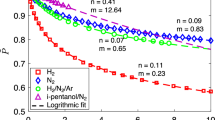Abstract
A counterflow reactor model for a system of two phases one of which involves an exothermic bimolecular reaction is considered. At a stationary temperature distribution in the reactor, there are high and low heating regions. For the adiabatic case, maximum heating is only possible at the bottom of the reactor. The maximum stationary temperature in the reactor decreases and shifts toward the top of the reactor as the intensity of heat exchange with the environment increases.
Similar content being viewed by others
References
G. Astarita, Mass Transfer with Chemical Reaction (Elsevier, Amsterdam, London, New York, 1967; Khimiya, Leningrad, 1971), p. 145.
E. Yu. Orlova, Chemistry and Technology of Brisant Explosives (Khimiya, Leningrad, 1973) [in Russian].
Technology of Ammonium Nitrate, Ed. by V. M. Olevskii (Khimiya, Moscow, 1978), p. 312 [in Russian].
L. D. Landau and E. M. Lifshitz, Course of Theoretical Physics, Vol. 6: Fluid Mechanics (Nauka, Moscow, 1986; Pergamon, New York, 1987), p. 100.
D. A. Frank-Kamenetskii, Diffusion and Heat Transfer in Chemical Kinetics (Nauka, Moscow, 1987) [in Russian].
Yu. P. Gupalo, A. D. Polyanin, and Yu. S. Ryazantsev, Mass and Heat Transfer between Reacting Particles and the Flow (Nauka, Moscow, 1985) [in Russian].
N. N. Kalitkin, Numerical Computation Methods (Nauka, Moscow, 1978) [in Russian].
N. N. Semenov, Zh. Russ. Fiz.-Khim. Obshch. 60, 241 (1928).
L. S. Pontryagin, Ordinary Differential Equations (Nauka, Moscow, 1965; Addison-Wesley, Reading, MA, 1962).
A. N. Tikhonov, Mat. Sb. 31, 575 (1952).
A. B. Vasil’eva and F. A. Butuzov, Asymptotic Expansion of Solutions to Singularly Perturbed Equations (Nauka, Moscow, 1973) [in Russian].
I. S. Lyubchenko, Dokl. Akad. Nauk SSSR 235, 1356 (1977).
A. G. Merzhanov, E. G. Zelikman, and V. G. Abramov, Dokl. Akad. Nauk SSSR 180, 639 (1968).
E. G. Zelikman, Fiz. Goreniya Vzryva, No. 4, 563 (1968)
Author information
Authors and Affiliations
Corresponding author
Additional information
Original Russian Text © E.V. Deyun, B.L. Korsunskii, N.G. Samoilenko, Yu.N. Finaeva, 2012, published in Khimicheskaya Fizika, 2012, Vol. 31, No. 1, pp. 33–37.
Rights and permissions
About this article
Cite this article
Deyun, E.V., Korsunskii, B.L., Samoilenko, N.G. et al. Thermal regimes of a counterflow reactor: a gas-liquid system. Russ. J. Phys. Chem. B 6, 28–32 (2012). https://doi.org/10.1134/S1990793112010058
Received:
Published:
Issue Date:
DOI: https://doi.org/10.1134/S1990793112010058




